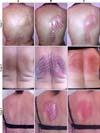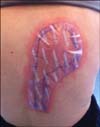Abstract
Notalgia paresthetica (NP) is a focal neuropathic itch condition manifesting in intense chronic or recurrent episodic itch in a hyperpigmented, macular, uni- or bilateral skin area located below and/or medially to the scapulae. Achieving satisfactory relieve in NP patients is challenging. In this case-series three female NP patients were treated with 8% capsaicin patches following a spatial quantification of their alloknetic area with a von Frey filament. The use of a von Frey filament in order to delimit the precise area of itch sensitization and thus patch application, proved clinically feasible. Although 8% topical capsaicin relieved itch in all three patients, the duration of the effectiveness varied greatly from only 3 days to >2 months. The treatment was well tolerated in the patients and there appear to be no significant hindrances to applying this treatment with NP as an indication, although it may only exhibit satisfactory effectiveness in certain patients. Placebo-controlled double-blinded trials are needed to confirm the effectiveness of the treatment and assess predictive parameters of the treatment outcome.
Notalgia paresthetica (NP) is a focal neuropathic itch condition that presents as a macular, unilateral or bilateral skin area located below and/or medially to the scapulae, giving rise to intense chronic itch frequently accompanied by post-inflammatory hyperpigmentation12. Although the chronic pruritus (CP) of NP is known to significantly impede life quality, the condition is estimated to be underdiagnosed and no evidence-based treatment regimen is currently established3.
Casuistically, transient relief of itch in NP has been reported upon treatment with anticonvulsants, transcutaneous nervous stimulation, and botulinum toxin-A34567. However, the effect of the latter was recently shown to be irreproducible in a small double-blinded study of 20 patients with NP8. In addition, high-concentration topical capsaicin treatment has occasionally been shown to alleviate itch in NP, most notably in two cases in which a considerable efficacy of 8% capsaicin topical patches was observed9. Capsaicin causes intense depolarization of epidermal transient receptor potential vanilloid 1 (TRPV1)-positive pruritic and nociceptive C-fibers10, resulting in prolonged, reversible deafferentation and defunctionalization. Qutenza (Astellas Pharma, Kastrup, Denmark) offers topical patch delivery of 8% capsaicin and is approved for the treatment of painful post-herpetic neuralgia11.
CP is often associated with itch-related dysesthesias, such as alloknesis, i.e. the perception of itch in response to normally innocuous stimuli, which is a concern for patient well-being and has not yet been assessed in patients with NP12. Here, the feasibility of using a 10 g Semmes-Weinstein nylon monofilament for sensory testing to map the area of alloknesis (similarly to the approach outlined in13) as a psychophysical biomarker and specifically treating this area was assessed. The present case series describes three severe NP cases in which treatment with 8% capsaicin provided a clinically significant decrease in itch intensity and frequency, ranging in duration from 2 days to 3 months.
A 54-year-old menopausal woman was referred due to long-standing intense itch, anatomically coinciding with hyperpigmentation of the upper right back (Fig. 1, 1A). The patient reported constant itch, rated 8~10 on a visual analog scale (visual analogue scale [VAS], 0~10; 0 denoting "no itch" and 10 denoting "worst imaginable itch") and severe, consistent sleep difficulties due to frequent nocturnal bouts of itching.
Previous unsuccessful attempts to treat her NP-induced CP included topical treatment with antifungal, corticosteroid, tacrolimus 0.1%, capsaicin 0.025%, and doxepin 5% creams. Only topical doxepin was shown to provide some relief (2~3 hours duration), but did not effectively relieve nightly bouts of itch. Histological examination of a 3-mm punch biopsy confirmed the presence of postinflammatory hyperpigmentation. The area of alloknesis was identified, which corresponded with the area of hyperpigmentation, except for a 2~4 cm border area with little or no hyperpigmentation.
After informed consent was obtained, the patient was treated with a topical 8% capsaicin patch for 1 hour. The treatment resulted in 7 weeks of complete itch relief, upon which a slow but steady reversal began. During re-examination and retreatment 3 months after the initial treatment, the patient reported that the returned CP was once again highly bothersome and sleep disruptive, but not entirely to the same extent as before the initial treatment. Of note, the intensity but not the area of the hyperpigmentation and the area of alloknesis to the nylon filament stimuli had diminished after the first treatment. Subsequent treatments with capsaicin 8% had comparable efficacy. By the third treatment, the area of alloknesis had retracted by approximately 15%~25% (Fig. 2).
A 49-year-old woman presented with itching and symmetrical bilateral hyperpigmentation below and medially to the scapulae (Fig. 1, 1B). She stated that the condition had emerged 5~6 years previously and reported 4~6 daily itch exacerbations, the itch intensity of which she rated at VAS=9. The patient also expressed concerns regarding the implications of the discoloration on her aesthetic appearance. The patient had undergone topical and systemic antifungal therapies in previous unsuccessful attempts to treat her pruritus. A biopsy revealed postinflammatory hyperpigmentation. The area of alloknesis slightly exceeded the area of hyperpigmentation.
After obtaining informed consent, the patient was treated with a topical 8% capsaicin patch for 1 hour. At follow-up, the patient reported that her itch had disappeared completely for 1 week, and thereafter very slowly receded toward baseline levels. Despite this slow reversal, the patient reported that, at the 3-month follow-up/retreatment, her average itch intensity remained lower compared to her pretreatment baseline levels of itch. At retreatment after 3 months, both the hyperpigmentation and the area of alloknesis had decreased considerably.
A 45-year-old woman was referred due to moderate itch of the upper back estimated to have persisted for approximately 20 years. The patient reported a constant itch rated at 3 on a VAS (0~10) and 1~3 daily itch exacerbations, the intensity of which she rated as 6~9. She reported experiencing typically two nightly itch-and-scratch bouts lasting several minutes each. She was taking no concomitant medication.
Inspection revealed no visible skin alterations in the area where the itch was perceived — medially to the left scapula (Fig. 1, 1C). The area of alloknesis could be identified using a 10 g nylon filament. After informed consent was obtained, the patient was treated with a topical 8% capsaicin patch for 1 hour. At follow-up, the patient reported that the itch had subsided completely for 2 days but thereafter rapidly returned to baseline levels. She underwent one additional treatment 3 months after with a similarly subpar treatment outcome.
Achieving satisfactory relief in patients suffering from neuropathic itch such as in NP is highly challenging. Etiologically, the involvement of the spinal nerves T2~T6 in NP is quite evident, but the nature of the pathophysiology at play in NP is unclear1. First, a reduced density of intra-epidermal sensory nerve fibers has been observed in NP-affected skin, which is paradoxically also a well-established reversible effect of high-concentration capsaicin1. Second, older literature hypothesized musculoskeletal impingement of the thoracic nerves, but supporting evidence is sparse114. Because the primary mechanism of action of topical capsaicin is a defunctionalization of intra-epidermal fibers, the apparent effectiveness of capsaicin in NP patients indicates a pathophysiological contribution from peripheral TRPV1+ C-fibers.
In the present case series, all subjects had significant erythema and moderate pain at the patch site during the application and ≈15~60 minutes after patch removal. No other side effects were reported, and the treatment-induced erythema did not evoke secondary hyperpigmentation in any of the subjects. The underlying cause of this noticeable difference in treatment response in NP is unknown, but similar response variation has been observed in the treatment of post-herpetic neuralgia15. Of interest, as can be seen in Fig. 1, 1A and 1B, the area of alloknesis extended beyond the hyperpigmented area, hinting that CP in NP might present as an area of spontaneously occurring itch with an area of alloknesis within its perimeter, wherein touch-evoked but not spontaneous itching occurs, thus making it less prone to frequent scratching and hence, to inflammation-induced hyperpigmentation.
Because the sensation of itch has low spatial resolution, identifying the location and exact area of itch is not a trivial task, particularly in patients without hyperpigmentation. It is concluded that it is clinically feasible to delimit the area of alloknesis, i.e., the itch-hypersensitive area with a 10 g von Frey filament (Fodplejedepotet HEWA, Gentofte, Denmark) in patients with NP. Two noticeable observations were made in the NP-affected skin in response to treatment. The area of hyperpigmentation diminished in size and/or intensity, and accordingly, the area of alloknesis was significantly reduced. This indicates that these parameters, when present, could be of potential use as severity/treatment response biomarkers if implemented in the routine assessment of NP.
The three patients reported here all experienced immediate relief of itch in response to 8% topical capsaicin, but the duration of the alleviation varied considerably. Studies exploring the potential prediction of treatment outcome to high-concentration capsaicin are warranted, particularly in light of the current price of the treatment. Qutenza (Astellas Pharma) was well tolerated by the patients, and there appear to be no significant hindrances to applying this treatment with NP as an indication.
Figures and Tables
 | Fig. 1Cases 1~3 before (A), during (B), and after (C) application of capsaicin. The blue marker signifies the predetermined area of alloknesis to von Frey pinprick. Notice that the area of alloknesis is larger than that of hyperpigmentation, particularly in case 1 and 3 and to a lesser extent in case 2. As evident in all 3 cases (B and C), the erythema extends beyond the area of application highlighting capsaicin-induced activation of C-mechano-insensitive-fibers. |
 | Fig. 2Case 1 at follow-up (and 2nd treatment), 3 months following the initial treatment. Notice the significantly retracted area of alloknesis indicated by the black demarcation (Fig. 1A, B for comparison). The patient also exhibited diminished hyperpigmentation. |
References
1. Huesmann T, Cunha PR, Osada N, Huesmann M, Zanelato TP, Phan NQ, et al. Notalgia paraesthetica: a descriptive two-cohort study of 65 patients from Brazil and Germany. Acta Derm Venereol. 2012; 92:535–540.

2. Ständer S, Weisshaar E, Mettang T, Szepietowski JC, Carstens E, Ikoma A, et al. Clinical classification of itch: a position paper of the International Forum for the Study of Itch. Acta Derm Venereol. 2007; 87:291–294.

3. Alai NN, Skinner HB, Nabili ST, Jeffes E, Shahrokni S, Saemi AM. Notalgia paresthetica associated with cervical spinal stenosis and cervicothoracic disk disease at C4 through C7. Cutis. 2010; 85:77–81.
4. Loosemore MP, Bordeaux JS, Bernhard JD. Gabapentin treatment for notalgia paresthetica, a common isolated peripheral sensory neuropathy. J Eur Acad Dermatol Venereol. 2007; 21:1440–1441.

5. Savk E, Bolukbasi O, Akyol A, Karaman G. Open pilot study on oxcarbazepine for the treatment of notalgia paresthetica. J Am Acad Dermatol. 2001; 45:630–632.

6. Savk E, Savk O, Sendur F. Transcutaneous electrical nerve stimulation offers partial relief in notalgia paresthetica patients with a relevant spinal pathology. J Dermatol. 2007; 34:315–319.

7. Weinfeld PK. Successful treatment of notalgia paresthetica with botulinum toxin type A. Arch Dermatol. 2007; 143:980–982.

8. Maari C, Marchessault P, Bissonnette R. Treatment of notalgia paresthetica with botulinum toxin A: a doubleblind randomized controlled trial. J Am Acad Dermatol. 2014; 70:1139–1141.

9. Metz M, Krause K, Maurer M, Magerl M. Treatment of notalgia paraesthetica with an 8% capsaicin patch. Br J Dermatol. 2011; 165:1359–1361.

10. O'Neill J, Brock C, Olesen AE, Andresen T, Nilsson M, Dickenson AH. Unravelling the mystery of capsaicin: a tool to understand and treat pain. Pharmacol Rev. 2012; 64:939–971.
11. Uçeyler N, Sommer C. High-dose capsaicin for the treatment of neuropathic pain: what we know and what we need to know. Pain Ther. 2014; 3:73–84.

12. Andersen HH, Elberling J, Arendt-Nielsen L. Human Surrogate Models of Histaminergic and Non-histaminergic Itch. Acta Derm Venereol. 2015; 95:771–777.

13. Højland CR, Andersen HH, Poulsen JN, Arendt-Nielsen L, Gazerani P. A Human Surrogate Model of Itch Utilizing the TRPA1 Agonist Trans-cinnamaldehyde. Acta Derm Venereol. 2015; 95:798–803.





 PDF
PDF ePub
ePub Citation
Citation Print
Print


 XML Download
XML Download